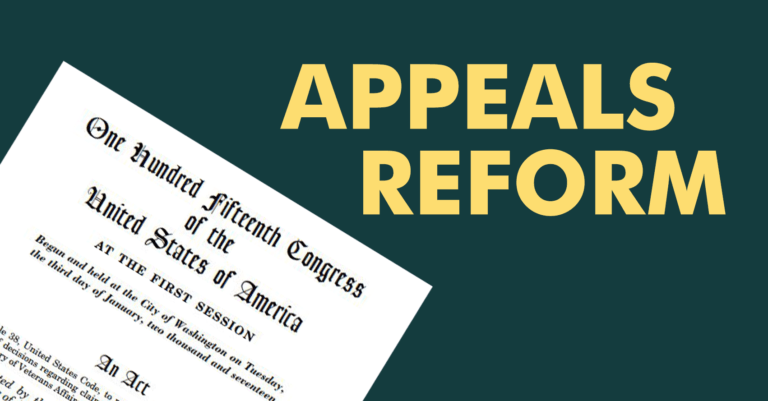Why Reform the Appeals System

The Veterans Appeals Improvement and Modernization Act of 2017 (Appeals Reform) began as a collaborative effort involving various stakeholders, including VA, Veterans Service Organizations, and Congressional Staff. It quickly gained bipartisan support and was signed into law on August 23, 2017. In November of 2017, VA introduced the Rapid Appeals Modernization Program (RAMP), which served as a pilot program to test the new appeals system. Initially, RAMP was only available to veterans through invitation. However, following a low opt-in rate, VA opened RAMP to all veterans with pending appeals in April 2018.
Despite extending RAMP eligibility to all veterans, VA only offered partial access to the pilot program, preventing RAMP participants from taking their claims to the Board of Veterans’ Appeals (Board). Instead, veterans were able to choose either the higher-level review lane or the supplemental claim lane when appealing. Yet this changed in October of 2018 when VA opened the Board lane to veterans enrolled in RAMP. As of now, RAMP will continue to operate until the full implementation of Appeals Reform, which is scheduled for February of 2019.
Motivation Behind Appeals Reform: More Choice for Veterans & VA Backlog
Appeals Reform is aimed towards restructuring the entire VA disability appeals process in order to simplify and streamline the parts of the current appeals process that typically increase wait times. Additionally, it intends to provide veterans, their families, and their survivors increased choice in handling disagreements with VA’s decisions. Generally speaking, VA’s total restructuring of the appeals system was prompted by the current system’s overall complexity and inefficiency. VA is unable to keep up with its workload while serving veterans in a timely manner. The number of claims received increases every year, adding onto the current VA backlog.
Problems with the Current Legacy System
In the current Legacy system, there is no defined endpoint or timeframe in regards to processing appeals. Instead, it features an open record and ongoing duty to assist. Such continuous evidence gathering and readjudication prolongs VA’s ability to reach a final decision. For example, in Fiscal Year 2016, it took an average of seven years from the date a Notice of Disagreement was filed to eventually receive a decision from the Board. Additionally, VA recognizes that the current system is too complicated as it contains too many steps and is difficult to communicate with veterans.
Benefits of Appeals Reform
The new appeals framework intends to address the above-mentioned issues by implementing an understandable review system that leads to the earlier resolution of disagreements. By increasing choice through multiple review options, veterans will be able to choose the one that best fits their situation. Nonetheless, choosing one lane over another does not prevent the veteran from later choosing a different lane. Under Appeals Reform, VA has proposed several timeframe goals including a 125-day goal for issuing decisions in both the higher-level review and supplemental claim lanes, and a 365-day goal for issuing decisions in the direct docket Board lane. While these goals are not guaranteed, VA will reportedly provide regular updates and estimates regarding wait times, thereby offering transparency throughout the appeals process. To ensure adherence to such timeframes, Appeals Reform limits both VA’s duty to assist and the open record that currently contribute to delays in the Legacy system. Specifically, VA’s duty to assist only applies in the supplemental claim lane, and there is a closed or limited window to submit evidence in two out of three of the lanes (i.e. the higher-level review lane and Board lane).
Under Appeals Reform, the Agency of Original Jurisdiction (AOJ) acts primarily as a claims agency while the Board acts as an appeals agency. AOJs are either VA Regional Offices or VA Medical Centers. Each adjudication under Appeals Reform will provide improved notice about the reasons for VA’s decision and the available review options. Namely, decisions under Appeals Reform will identify the issues adjudicated, favorable findings, the elements not satisfied, and the criteria needed to grant service connection or an increased rating. Additionally, if either the Board or higher-level reviewers find issues with the decision on appeal, quality feedback will be provided to the AOJ, increasing accountability amongst adjudicators. To learn more and see possible lane options, please check out our VA appeals process interactive tool.
About the Author
Share this Post
